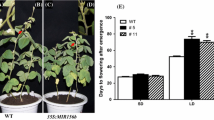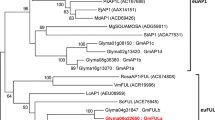Abstract
Flowering time, maturity, and plant morphology have considerable effects on the adaptation and grain yield of soybean (Glycine max). The identification of novel genes and an understanding of their molecular basis are critical to improve soybean productivity. In this study, we cloned a flowering time related APETALA2-like gene GmTOE4a and generated GmTOE4a-overexpressing lines in the cultivar Williams 82. The transgenic lines exhibited late flowering both under long day and short day conditions, and repressed the flowering-related genes, including GmFT2a, GmFT5a, GmAP1, and GmLFY, whereas the flowering repressors GmFT4 and miR156 were upregulated. Interestingly, GmTOE4a was also mediated by photoperiod via maturity genes E3 and E4, which encode photoreceptors in soybean. Further, miR172-mediated GmTOE4a, which regulates flowering in soybean, is different in Arabidopsis in that it is dependent on the CONSTANS-like gene GmCOL1a. In addition to its effect on flowering time, GmTOE4a regulated plant morphology, increased stem thickness, and reduced plant height, internode length and leaf size, which are important agronomic traits that enhance the capacity to resist lodging and increase soybean yield. This is useful information to understand the molecular mechanism of flowering time and plant morphology in soybean and will greatly influence soybean yield improvement.








Similar content being viewed by others
References
Aukerman MJ, Sakai H (2003) Regulation of flowering time and floral organ identity by a microRNA and its APETALA2-like target genes. Plant Cell 15:2730–2741
Bernard RL (1971) Two major genes for time of flowering and maturity in soybeans. Crop Sci 11:242–244
Bonato ER, Vello NA (1999) E6, a dominant gene conditioning early flowering and maturity in soybeans. Genet Mol Biol 22:229–232
Buzzell RI (1971) Inheritance of a soybean flowering response to fluorescent-daylength conditions. Can J Genet Cytol 13:703–707
Buzzell R, Voldeng H (1980) Inheritance of insensitivity to long daylength. Soybean Genet Newsl 7:26–29
Cardon G, Höhmann S, Nettesheim K, Saedler H, Huijser P (1997) Functional analysis of the Arabidopsis thaliana SBP-bx gene SPL3: a novel gene involved in the floral transition. Plant J 12:367–377
Chen X (2004) A microRNA as a translational repressor of APETALA2 in Arabidopsis flower development. Science 303:2022–2025
Chi Y, Huang F, Liu H, Yang S, Yu D (2011) An APETALA1-like gene of soybean regulates flowering time and specifies floral organs. J Plant Physiol 168:2251–2259
Cober ER, Voldeng HD (2001) Low R: FR light quality delays flowering of E7E7 soybean lines. Crop Sci 41:1823–1826
Cober ER, Molnar SJ, Charette M, Voldeng HD (2010) A new locus for early maturity in soybean. Crop Sci 50:524–527
Dunnett CW (1955) A multiple comparison procedure for comparing several treatments with a control. J Am Stat Assoc 50:1096–1121
Flores T, Karpova O, Su X, Zeng P, Bilyeu K, Sleper DA, Nguyen HT, Zhang ZJ (2008) Silencing of GmFAD3 gene by siRNA leads to low α-linolenic acids (18:3) of fad3-mutant phenotype in soybean [Glycine max (Merr.)]. Transgenic Res 17:839–850
Gandikota M, Birkenbihl RP, Hohmann S, Cardon GH, Saedler H, Huijser P (2007) The miRNA156/157 recognition element in the 3′UTR of the Arabidopsis SBP box gene SPL3 prevents early flowering by translational inhibition in seedlings. Plant J 49:683–693
Jung JH, Seo YH, Seo PJ, Reyes JL, Yun J, Chua NH, Park CM (2007) The GIGANTEA-regulated microRNA172 mediates photoperiodic flowering independent of CONSTANS in Arabidopsis. Plant Cell 19:2736–2748
Jung JH, Seo PJ, Kang SK, Park CM (2011) miR172 signals are incorporated into the miR156 signaling pathway at the SPL3/4/5 genes in Arabidopsis developmental transitions. Plant Mol Biol 76:35–45
Jung JH, Lee S, Yun J, Lee M, Park CM (2014) The miR172 target TOE3 represses AGAMOUS expression during Arabidopsis floral patterning. Plant Sci 215–216:29–38
Kong F, Liu B, Xia Z, Sato S, Kim BM, Watanabe S, Yamada T, Tabata S, Kanazawa A, Harada K, Abe J (2010) Two coordinately regulated homologs of FLOWERING LOCUS T are involved in the control of photoperiodic flowering in soybean. Plant Physiol 154:1220–1231
Kong F, Nan H, Cao D, Li Y, Wu F, Wang J, Lu S, Yuan X, Cober ER, Abe J, Liu B (2014) A new dominant gene E9 conditions early flowering and maturity in soybean. Crop Sci. doi:10.2135/cropsci2014.03.0228
Lauter N, Kampani A, Carlson S, Goebel M, Moose SP (2005) microRNA172 down-regulates glossy15 to promote vegetative phase change in maize. Proc Natl Acad Sci USA 102:9412–9417
Liu B, Kanazawa A, Matsumura H, Takahashi R, Harada K, Abe J (2008) Genetic redundancy in Soybean photoresponses associated with duplication of the Phytochrome A gene. Genetics 180:995–1007
Martin A, Adam H, Díaz-Mendoza M, Zurczak M, González-Schain N, Suárez-López P (2009) Graft-transmissible induction of potato tuberization by the microRNA miR172. Development 136:2873–2881
Mathieu J, Yant LJ, Mürdter F, Küttner F, Schmid M (2009) Repression of flowering by the miR172 target SMZ. PLoS Biol 7(7):e1000148. doi:10.1371/journal.pbio.1000148
McBlain B, Bernard R (1987) A new gene affecting the time of flowering and maturity in soybeans. J Hered 78:160–162
Na X, Jian B, Yao W, Wu C, Hou W, Jiang B, Bi Y, Han T (2013) Cloning and functional analysis of the flowering gene GmSOC1-like, a putative SUPPRESSOR OF OVEREXPRESSION CO1/AGAMOUS-LIKE 20 (SOC1/AGL20) ortholog in soybean. Plant Cell Rep 32:1219–1229
Nan H, Cao D, Zhang D, Li Y, Lu S, Tang L, Yuan X, Liu B, Kong F (2014) GmFT2a and GmFT5a redundantly and differentially regulate flowering through interaction with and upregulation of the bZIP transcription factor GmFDL19 in soybean. PLoS ONE 9:e97669
Preston JC, Hileman LC (2013) Functional evolution in the plant SQUAMOSA-PROMOTER BINDING PROTEIN-LIKE (SPL) gene family. Front Plant Sci 4:1–13
Ray JD, Hinson K, Mankono J, Malo MF (1995) Genetic-control of a long-juvenile trait in soybean. Crop Sci 35:1001–1006
Schwab R, Palatnik JF, Riester M, Schommer C, Schmid M, Weigel D (2005) Specific effects of microRNAs on the plant transcriptome. Dev Cell 8:517–527
Schwarz S, Grande AV, Bujdoso N, Saedler H, Huijser P (2008) The microRNA regulated SBP-box genes SPL9 and SPL15 control shoot maturation in Arabidopsis. Plant Mol Biol 67:183–195
Sun H, Jia Z, Cao D, Jiang B, Wu C, Hou W, Liu Y, Fei Z, Zhao D, Han T (2011) GmFT2a, a soybean homolog of FLOWERING LOCUS T, is involved in flowering transition and maintenance. PLoS ONE 6(12):e29238
Telfer A, Bollman KM, Poethig RS (1997) Phase change and the regulation of trichome distribution in Arabidopsis thaliana. Development 124:645–654
Thakare D, Kumudini S, Dinkins RD (2011) The alleles at the E1 locus impact the expression pattern of two soybean FT-like genes shown to induce flowering in Arabidopsis. Planta 234:933–943
Turner M, Adhikari S, Subramanian S (2013) Optimizing stem-loop qPCR assays through multiplexed cDNA synthesis of U6 and miRNAs. Plant Signal Behav 8:e24918-1-4
Wang J, Schwab R, Czech B, Mica E, Weigel D (2008) Dual effects of miR156-targeted SPL genes and CYP78A5/KLUH on plastochron length and organ size in Arabidopsis thaliana. Plant Cell 20:1231–1243
Watanabe S, Hideshima R, Xia Z, Tsubokura Y, Sato S, Nakamoto Y, Yamanaka N, Takahashi R, Ishimoto M, Anai T, Tabata S, Harada K (2009) Map-based cloning of the gene associated with the soybean maturity locus E3. Genetics 182:1251–1262
Watanabe S, Xia Z, Hideshima R, Tsubokura Y, Sato S, Yamanaka N, Takahashi R, Anai T, Tabata S, Kitamura K, Harada K (2011) A map-based cloning strategy employing a residual heterozygous line reveals that the GIGANTEA gene is involved in soybean maturity and flowering. Genetics 188:395–407
Wu G, Poethig RS (2006) Temporal regulation of shoot development in Arabidopsis thaliana by miR156 and its target SPL3. Development 133:3539–3547
Wu G, Park MY, Conway SR, Wang JW, Weigel D, Poethig RS (2009) The sequential action of miR156 and miR172 regulates developmental timing in Arabidopsis. Cell 138:750–759
Wu F, Price BW, Haider W, Seufferheld G, Nelson R, Hanzawa Y (2014) Functional and evolutionary characterization of the CONSTANS gene family in short-day photoperiodic flowering in soybean. PLoS ONE 9(1):e85754. doi:10.1371/journal.pone.0085754
Xia Z, Watanabe S, Yamada T, Tsubokura Y, Nakashima H, Zhai H, Anai T, Sato S, Yamazaki T, Lu S, Wu H, Tabata S, Harada K (2012a) Positional cloning and characterization reveal the molecular basis for soybean maturity locus E1 that regulates photoperiodic flowering. Proc Natl Acad Sci 109:E2155–E2164
Xia Z, Zhai H, Liu B, Kong F, Yuan X, Wu H, Cober ER, Harada K (2012b) Molecular identification of genes controlling flowering time, maturity, and photoperiod response in soybean. Plant Syst Evol 298:1217–1227
Yamashino T, Yamawaki S, Hagui E, Ishida K, Ueoka-Nakanishi H, Nakamichi N, Mizuno T (2013) Clock-controlled and FLOWERING LOCUS T (FT)-dependent photoperiodic pathway in Lotus japonicus II: characterization of a microRNA implicated in the control of flowering time. Biosci Biotechnol Biochem 77:1179–1185
Zhai H, Lü S, Liang S, Wu H, Zhang X, Liu B, Kong F, Yuan X, Li J, Xia Z (2014) GmFT4, a homolog of FLOWERING LOCUS T, is positively regulated by E1 and Functions as a flowering repressor in Soybean. PLoS ONE 9(2):e89030. doi:10.1371/journal.pone.0089030
Zhong X, Dai X, Xv J, Wu H, Liu B, Li H (2012) Cloning and expression analysis of GmGAL1, SOC1 homolog gene in soybean. Mol Biol Rep 39:6967–6974
Zhu QH, Upadhyaya NM, Gubler F, Helliwell CA (2009) Over-expression of miR172 causes loss of spikelet determinacy and floral organ abnormalities in rice (Oryza sativa). BMC Plant Biol 9:149
Acknowledgments
We thank Dr. Kan Wang for providing the soybean transformation vector pTF101.1 and the Agrobacterium strain EHA101. This work was supported by the National Natural Science Foundation of China (31430065, 31371643, 31071445, 31171579 and 31201222); the Open Foundation of the Key Laboratory of Soybean Molecular Design Breeding, Chinese Academy of Sciences; the “Hundred Talents” Program of the Chinese Academy of Sciences; the Strategic Action Plan for Science and Technology Innovation of the Chinese Academy of Sciences (XDA08030108); and the Heilongjiang Natural Science Foundation of China (ZD201001, JC201313).
Conflict of interest
The authors declare that they have no conflict of interest.
Author information
Authors and Affiliations
Corresponding authors
Additional information
Xiaohui Zhao and Dong Cao have contributed equally to this work.
Electronic supplementary material
Below is the link to the electronic supplementary material.
Rights and permissions
About this article
Cite this article
Zhao, X., Cao, D., Huang, Z. et al. Dual functions of GmTOE4a in the regulation of photoperiod-mediated flowering and plant morphology in soybean. Plant Mol Biol 88, 343–355 (2015). https://doi.org/10.1007/s11103-015-0322-1
Received:
Accepted:
Published:
Issue Date:
DOI: https://doi.org/10.1007/s11103-015-0322-1




